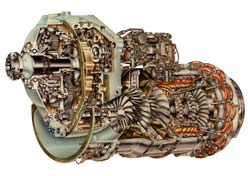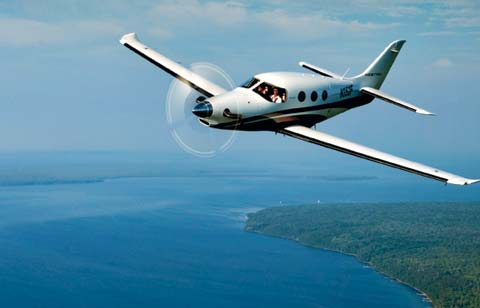Kestrel’s Klapmeier tackles Piper Meridian
Honeywell engine picked to power Kestrel turboprop
In an effort to spool up revenues and create jobs at its Brunswick, Maine, factory, Kestrel Aircraft will begin upgrading existing high-performance airplanes, said company president Alan Klapmeier at EAA AirVenture 2011. The new division, called Kestrel Aeroworks, will initially focus on installing the Avidyne Release 9 panel in older Piper Meridian and Cirrus aircraft. Other high-hull-value models may follow.
Klapmeier said the Avidyne installation will include a completely new panel that will make the airplanes more “user friendly.” Although he didn’t provide specific examples, Klapmeier said he has been flying an older Meridian recently and found several comfort and convenience factors missing. Placement of switches and other components can be improved, and he will use his experience in making the Cirrus cockpit and interior more functional to improve the Meridian’s interior. Work on one Meridian is already under way and another will begin shortly. Prices will vary depending on options already on the airplane, but Klapmeier estimated such an upgrade might cost $130,000.
Meanwhile, Klapmeier has selected the Honeywell TPE331-14GR engine to power the Kestrel single-engine turboprop that is the president’s primary focus. Klapmeier said they considered a Pratt & Whitney PT6 engine, as powers the currently flying proof-of-concept aircraft. However, the Honeywell engine was chosen for its user friendly approach. The engine can be started by selecting a single button.
The production Kestrel under development will have a larger cabin diameter and larger baggage area than the proof-of-concept aircraft and will include a spar buried under the floor. A new mockup at AirVenture showcases larger windows and a wider aisle than the proof of concept.
According to Mike Bevans, Honeywell senior director of technical sales for business and general aviation, the TPE331-14 is the same engine used on the Jetstream 41 regional airliner, which has flown some 5.1 million hours. The engine is rated at 1,600 shaft horsepower with a thermodynamic horsepower rating of 1,760 shp. The Kestrel engine will be derated to around 1,000 shp, he predicted.
 While the engine on the J41 has a 9,000 hour TBO with a 4,500 hot section inspection required, Bevans said the Kestrel engine will have a lower TBO because of the amount of time it would take the typical owner-operator to reach 9,000 hours. The engine that will power the Kestrel will be nearly off the shelf, according to Bevans, an attempt by Klapmeier to reduce risk in the program.
While the engine on the J41 has a 9,000 hour TBO with a 4,500 hot section inspection required, Bevans said the Kestrel engine will have a lower TBO because of the amount of time it would take the typical owner-operator to reach 9,000 hours. The engine that will power the Kestrel will be nearly off the shelf, according to Bevans, an attempt by Klapmeier to reduce risk in the program.
The TPE-331 is a single-shaft engine with dual centrifugal compressors. Some 200 variants of the engine have been produced, yielding 13,000 total engines that have flown 118 million hours.
While the prop turns at 1,550 rpm, making it quiet in cruise, operation at low power setting, such as in taxiing, causes the engine to be noisy on the ramp—the result of the compressor running outside its optimum design area, according to Bevans. Inlet design changes for the Kestrel installation will help muffle some of that noise on the ramp while not compromising cruise performance, Bevans said.
Klapmeier said he had a goal line of three years to begin deliveries of the Kestrel from the Brunswick factory. Two rounds of funding have positioned the company to begin the production of the first prototype.
The company is not yet taking orders for the eight-seat, 320-knot turboprop, but it is allowing those with an interest to put their names on a list to be contacted when the order book is open. When deposits are accepted, they will be held in escrow until certain milestones are met.


